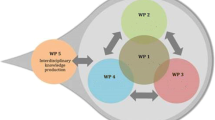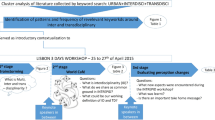Abstract
This paper identifies what can be called the ‘paradox of interdisciplinarity’ (Weingart 2000) in Australian higher education research governance and explores some of its constitutive dimensions. In the Australian context, the paradox of interdisciplinarity primarily concerns the proliferation of a programmatic discourse of interdisciplinarity in government reports and government policy and strategy documents, often tied to notions of innovation and applicability, parallel to the persistence or even reinforcement of modes of governance and associated mechanisms that almost exclusively rely on rigid discipline-based classification systems to evaluate and fund research. Two interrelated dimensions of this apparent paradox are discussed. First, the conceptions of knowledge that underpin the use of notions of disciplinarity as well as interdisciplinarity in Australian government reports and policy and strategy papers are analysed. Second, an analysis of the Australian research governance system and its underlying mechanisms is presented, as they pertain to interdisciplinary forms of research. On the basis of these analyses, it is concluded that there is a significant mismatch between the discourse of interdisciplinarity and associated conceptions of knowledge on the one hand, and current, relatively inflexible governmental research funding and evaluation practices on the other. It is finally proposed that the occurrence and perpetuation of such a mismatch in the Australian context can only be understood properly if placed in the context of a more general paradox of research governance, where a politically charged rhetoric of innovation conflicts with the actual trend toward an increasingly diminishing scope for the self-organisation of knowledge.
Similar content being viewed by others
Notes
In the Australian context, the ARC is responsible for providing grants for basic and applied research activities in all fields except those undertaken in medicine and dentistry.
The other two sets of classification are ‘type of activity’ (e.g., pure basic research or applied research) and ‘socio-economic objective’.
The term ‘interdisciplinarity’ as such appears for the first time in the 1998 ASRC in the form of various references to the ‘discipline’ of ‘interdisciplinary engineering’. In both the 1993 and 1998 ASRC documents one can further find a few references to multidisciplinary research, where such research appears to be conceived as the collaboration of various, disparate fields, without involving synthesis or integration (ABS 1993, 2; ABS 1998, 3).
References
Abbott, A. (2001). Chaos of disciplines. Chicago: University of Chicago Press.
Australian Bureau of Statistics (ABS) (1993). Australian Standard Research Classification 1993. A set of classifications for R&D projects. ABS catalogue no. 1297.0. Canberra: ABS.
Australian Bureau of Statistics (ABS) (1998). Australian Standard Research Classification 1998. A set of classifications for R and D projects. ABS catalogue no. 1297.0. Canberra: ABS.
Australian Bureau of Statistics (ABS) and Statistics New Zealand (SNZ) (2008). Australian and New Zealand Standard Research Classification (ANZSRC) 2008. ABS catalogue no. 1297.0. Canberra: ABS.
Bammer, G. (2012). Strengthening interdisciplinary research: What it is, what it does, how it does it and how it is supported. Report for the Australian Council of Learned Academies (ACOLA). URL: http://www.acola.org.au/ACOLA/Interdisciplinary_Research_Report_files/112462%20Acadamy%20of%20Tech%20LR_1.pdf.
Bowker, G. C., & Star, S. L. (1999). Sorting things out: Classification and its consequences. Cambridge: MIT Press.
Coaldrake, P., & Stedman, L. (1999). Academic work in the Twenty-first century: Changing roles and policies. Occasional paper series 99H, Higher Education division. Canberra: Department of Education, Training and Youth Affairs.
Department of Innovation, Industry, Science and Research (DIISR). (2009). Powering ideas: An innovation agenda for the 21st century. Canberra: DIISR.
Department of Innovation, Industry, Science and Research (DIISR). (2011a). Research skills for an innovative future: A research workforce strategy to cover the decade to 2020 and beyond. Canberra: DIISR.
Department of Innovation, Industry, Science and Research (DIISR) (2011b). Focusing Australia’s publicly funded research review. Maximising the innovation dividend: Review key findings and future directions. Canberra: DIISR.
Edqvist, O. (2003). Layered science and science policies. Minerva: A Review of Science, Learning, and policy, 41(3), 207–221.
Feller, I. (2006). Multiple actors, multiple settings, multiple criteria: Issues in assessing interdisciplinary research. Research Evaluation, 15(1), 5–15.
Geuna, A., & Martin, B. R. (2003). University research evaluation and funding: An international comparison. Minerva: A Review of Science, Learning, and Policy, 41(4), 277–304.
Gibbons, M., Limoges, C., Nowotny, H., Schwartzman, S., Scott, P., & Trow, M. (1994). The new production of knowledge the dynamics of science and research in contemporary societies. London: Sage.
Gläser, J., & Laudel, G. (2007). Evaluation without evaluators: The impact of funding formulae on Australian university research. In R. Whitley & J. Gläser (Eds.), The Changing governance of the sciences: The advent of research evaluation systems (pp. 127–151). Dordrecht: Springer.
Grigg, L. (1999). Cross-disciplinary research: A discussion paper. Commissioned report no. 61. Canberra: Australian Research Council.
Gumport, P. J. (2000). Academic restructuring: Organizational change and institutional imperatives. Higher Education, 39, 67–91.
Jacobs, J. A., & Frickel, S. (2009). Interdisciplinarity: A critical assessment. Annual Review of Sociology, 35, 43–65.
Johnston, R. (1998). The changing nature and forms of knowledge: A review. Evaluation and Investigations Programme Higher Education Division 98/16. Canberra: Department of Employment, Education, Training and Youth Affairs.
Kemp, D. (1999a). New knowledge, new opportunities: A discussion paper on higher education research and research training. Canberra: Department of Education, Training and Youth Affairs.
Kemp, D. (1999b). Knowledge and innovation: A policy statement on research and research training. Canberra: Department of Education, Training and Youth Affairs.
Klein, J. T. (1990). Interdisciplinarity: History, theory and practice. Detroit: Wayne State University Press.
Klein, J. T. (1996a). Crossing boundaries: Knowledge, disciplinarities, and interdisciplinarities. Charlottesville: University Press of Virginia.
Klein, J. T. (1996b). Interdisciplinary needs: The current context. Library Trends, 45(2), 134–154.
Klein, J. T. (2000). A conceptual vocabulary of interdisciplinary science. In P. Weingart & N. Stehr (Eds.), Practising Interdisciplinarity (pp. 3–24). Toronto: University of Toronto Press.
Lamont, M., Mallard, G., & Guetzkow, J. (2006). Beyond blind faith: Overcoming obstacles to interdisciplinary evaluation. Research Evaluation, 15(1), 43–55.
Larkins, F. P. (2011). Australian higher education research policies and performance 1987–2010. Carlton: Melbourne University Press.
Mansilla, V. B., Feller, I., & Gardner, H. (2006). Quality assessment in interdisciplinary research and education. Research Evaluation, 15(1), 69–74.
Marginson, S. (1993). Education and public policy in Australia. Cambridge: Cambridge University Press.
Marginson, S., & Considine, M. (2000). The enterprise university: Power, governance and reinvention in Australia. Cambridge: Cambridge University Press.
Moore, R. (2010). Making the break: Disciplines and interdisciplinarity. In F. Christie & K. Maton (Eds.), Disciplinarity: Functional linguistic and sociological perspectives (pp. 87–105). London: Continuum.
Nowotny, H., Scott, P., & Gibbons, M. (2001). Re-thinking science: Knowledge and the public in an age of uncertainty. Cambridge: Polity Press.
Nowotny, H., Scott, P., & Gibbons, M. (2003). Introduction: ‘Mode 2’ revisited: The new production of knowledge. Minerva: A Review of Science, Learning, and Policy, 41(3), 179–194.
Organization for Economic Cooperation and Development (OECD). (1982). The university and the community: The problem of changing relationships. Paris: OECD.
Rhoten, D. (2005). Interdisciplinary research: Trend or transition. Items and Issues, 5(1–2), 6–11.
Rosch, E. (1978). Principles of categorization. In E. Rosch & B. B. Lloyd (Eds.), Cognition and categorization (pp. 27–48). Hillsdale: Lawrence Erlbaum.
Sá, C. M. (2008). ‘Interdisciplinary strategies’ in US research Universities. Higher Education, 55(5), 537–552.
Sokal, R. R. (1974). Classification: Purposes, principles, progress, prospects. Science, 185(4157), 1115–1123.
Stichweh, R. (1992). The sociology of scientific disciplines: On the genesis and stability of the disciplinary structure of modern science. Science in Context, 5, 3–15.
Swoboda, W. W. (1979). Disciplines and interdisciplinarity: A historical perspective. In J. J. Kockelmans (Ed.), Interdisciplinarity and higher education (pp. 49–92). University Park, Pennsylvania: Penn State University Press.
van Leeuwen, T., & Tijssen, R. (2000). Interdisciplinary dynamics of modern science: Analysis of cross-disciplinary citation flows. Research Evaluation, 9(3), 183–187.
Weingart, P. (1997). From ‘Finalization’ to ‘Mode 2’: Old wine in new bottles? Social Science Information, 36(4), 591–613.
Weingart, P. (2000). Interdisciplinarity: The paradoxical discourse. In P. Weingart & N. Stehr (Eds.), Practising interdisciplinarity (pp. 25–41). Toronto: University of Toronto Press.
Whitley, R. (2007). Changing governance of the public sciences: The consequences of establishing research evaluation systems for knowledge production in different countries and scientific fields. In R. Whitley & J. Gläser (Eds.), The changing governance of the sciences: The advent of research evaluation systems (pp. 3–27). Dordrecht: Springer.
Whitley, R., & Gläser, J. (Eds.). (2007). The changing governance of the sciences: The advent of research evaluation systems. Dordrecht: Springer.
Whitley, R., Gläser, J., & Engwall, L. (Eds.). (2010). Reconfiguring knowledge production: Changing authority relationships in the sciences and their consequences for intellectual innovation. Oxford: Oxford University Press.
Acknowledgments
We wish to acknowledge Australian Research Council funding support for the research project ‘Knowledge Building in Schooling and Higher Education: Policy strategies and effects’ (ARC Discovery Project 2011–13, DP110102466, Chief Investigator Prof. Lyn Yates). We would also like to thank the other researchers on the project, Prof. Lyn Yates and Kate O'Connor, as well as the anonymous reviewers for their feedback and suggestions.
Author information
Authors and Affiliations
Corresponding author
Rights and permissions
About this article
Cite this article
Woelert, P., Millar, V. The ‘paradox of interdisciplinarity’ in Australian research governance. High Educ 66, 755–767 (2013). https://doi.org/10.1007/s10734-013-9634-8
Published:
Issue Date:
DOI: https://doi.org/10.1007/s10734-013-9634-8




